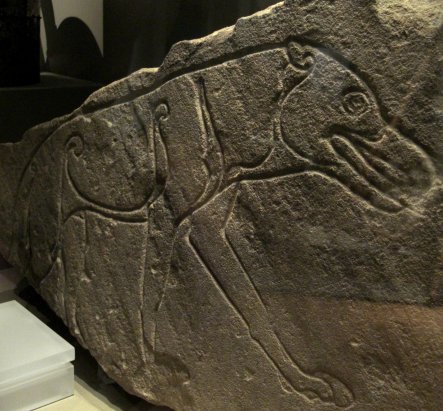<< Feature Articles >> The Origin of the Prehistoric Dog - a Story Full of Scientific Controversy
Submitted by Matthew_Coulton on Wednesday, 23 May 2018 Page Views: 2184
Discoveries
Biological Roots: Geographical Origins – The Fossil Record
The oldest fossil remains of dogs are found in two geographic regions. In western Europe, dog fossils dating back 15,000 years have been found. And in east Asia, archaeologists have located dog fossils dating back 12,500 years. There are also some outlier fossil remains, such as a skull found in a cave in Belgium that dates back as far as 36,000 years ago, although this is disputed by some researchers.Modern DNA Studies
An exciting study of modern day wolves and domesticated dogs was undertaken in 2016 in an attempt to decode the story of domestic dogs using a whole-genome analysis of a large sample of specimens. Unfortunately, due probably to intermixing between different lineages of domesticated dogs, and various interbreeding back with wolves over the intervening time, the study did not yield definitive results on the exact origins of domestic dogs.Cultural Shifts
One of the most interesting things about the relationship between humans and dogs goes beyond biology, and towards that deep shift in human culture that followed our partnership.Remarkably, it was not only the bone structure, fur color and shape of the ears on canines that started to change when dogs and humans started spending more time together, their psychology and ability to read human facial expressions changed as well.
Chicken or the Egg?
As origin stories often do, the question of who made the first move is one of the great controversies that persists in terms of understanding the beginnings of the dog/human partnership. Some evidence points to the fact that humans, hunters and gatherers at the time, captured and actively bred and tamed wild wolves. On the other hand, some evolutionary biologists think the wolves initiated first contact by taking advantage of human waste - scavenging the remains of carcasses and spending more time close to humans as a result.
Some evidence points to the fact that humans, hunters and gatherers at the time, captured and actively bred and tamed wild wolves. On the other hand, some evolutionary biologists think the wolves initiated first contact by taking advantage of human waste - scavenging the remains of carcasses and spending more time close to humans as a result. Even with all this research, it is still not certain if the dog became the modern-day species we know today on its own by evolving over generations to have less fear and aggression towards humans, or if selective and intentional breeding created the modern-day dog, Canis familiaris.
The Co-Evolution of Dogs and Humans
Humans are fairly ego driven when it comes to understanding our impact on other species. There is a wide tendency, even for most of the history of the life sciences, to see the relationship between humans and other animals as one where the humans are the agents of change, and other animals as on the receiving end of our actions.The story of dogs is one area of evolutionary science that is deeply challenging this long held bias of a human centered world. In fact, "co-evolution" is now a popular model used to understand how dogs and humans have both been deeply affected by a cooperative relationship over thousands of generations.
Several biological shifts occurred simultaneously in both groups, including an increased ability to digest starches and the serotonin processing capacity of the brain which is also tied to aggression modulation.
 The domestication of dogs was also profoundly cultural. Hunting with dogs may well have shifted the kinds of prey humans relied on, making hunting a much safer endeavor, and helping to forge a lasting relationship with the first canine companions. In fact, some researchers have argued that the human-dog bond is part of the reason that Homo Sapiens won out over the now extinct Neanderthals.
The domestication of dogs was also profoundly cultural. Hunting with dogs may well have shifted the kinds of prey humans relied on, making hunting a much safer endeavor, and helping to forge a lasting relationship with the first canine companions. In fact, some researchers have argued that the human-dog bond is part of the reason that Homo Sapiens won out over the now extinct Neanderthals. If this theory is correct, then it dates the origins of the dog and human partnership back to at least 33,000 years ago, which brings us back to the beginning of this story.
More questions than answers seems to be the norm in the scientific research trying to understand the origin of the modern day dog. While we may never know for sure, the investigation of this fascinating partnership continues to help us understand both ourselves and our own origins. To learn more, follow the various links in the article and see the references below.
Author Bio:
Mathew has worked with dogs for just under a decade and is the founder of wileypup.com, a dog lover’s website that provides great tips and advice for paw parents everywhere.
<< Standing stones and other ancient sites to visit in Prague






 We would like to know more about this location. Please feel free to add a brief description and any relevant information in your own language.
We would like to know more about this location. Please feel free to add a brief description and any relevant information in your own language. Wir möchten mehr über diese Stätte erfahren. Bitte zögern Sie nicht, eine kurze Beschreibung und relevante Informationen in Deutsch hinzuzufügen.
Wir möchten mehr über diese Stätte erfahren. Bitte zögern Sie nicht, eine kurze Beschreibung und relevante Informationen in Deutsch hinzuzufügen. Nous aimerions en savoir encore un peu sur les lieux. S'il vous plaît n'hesitez pas à ajouter une courte description et tous les renseignements pertinents dans votre propre langue.
Nous aimerions en savoir encore un peu sur les lieux. S'il vous plaît n'hesitez pas à ajouter une courte description et tous les renseignements pertinents dans votre propre langue. Quisieramos informarnos un poco más de las lugares. No dude en añadir una breve descripción y otros datos relevantes en su propio idioma.
Quisieramos informarnos un poco más de las lugares. No dude en añadir una breve descripción y otros datos relevantes en su propio idioma.